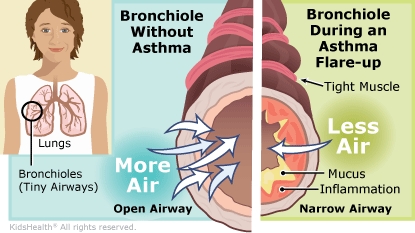During an asthma flare-up, the muscles around the airways tighten. The lining of the airways gets inflamed, causing it to swell and fill with mucus. All these changes make it hard to breathe. A child having a flare-up may cough a lot, wheeze, feel chest tightness, or be short of breath. Asthma flare-ups, sometimes called asthma attacks, can be serious. That's why it's important to treat a flare-up as soon as symptoms start.
The health care provider examined your child and asked questions about symptoms. They may have given your child medicine to stop the asthma flare-up or prescribed medicine to use at home. Your child is doing better and you can continue care at home.
The health care provider might have given you an asthma action plan or reviewed the plan with you and your child if you already have one. An asthma action plan is a set of instructions that detail how to manage asthma at home. Keeping the plan up to date and following it closely can help a person prevent or treat symptoms and keep their asthma under control. It's important that you and your child understand the asthma action plan, know the signs of a flare-up, and know what to do if a flare-up happens.


As your child gets better from this flare-up:
When your child's breathing is back to normal:

Your child:

Your child has trouble breathing. Signs you might see include:
Call 911 if your child is struggling to breathe, is too out of breath to talk or walk, or turns blue.

What is asthma? Asthma is a condition that causes breathing problems. It is a chronic (ongoing) condition, which means it usually lasts for years, though many kids grow out of it. Asthma can be mild or so severe that it gets in the way of daily activities. But with medicine and the right care plan, asthma symptoms can be managed so that kids can do just about anything they want to do.
What is an asthma flare-up? An asthma flare-up is when asthma symptoms get worse. These symptoms include wheezing, coughing, or feeling out of breath. People with asthma have airways that are overly sensitive to some things (called "triggers"). Being around triggers can bring on asthma symptoms by making the airways in the lungs narrower, swollen, and filled with mucus. Asthma flare-ups are also called asthma attacks or exacerbations. They can happen even when a person takes medicine to control their asthma.
What are common asthma triggers? A trigger is something that can cause asthma symptoms to start. A trigger does not cause asthma. Triggers are different for each person. Common asthma triggers include:
How do asthma medicines work? Asthma medicines generally work in two ways:
Some children will get both types of medicines from one inhaler device. They might need to use this "combination" inhaler every day, with added doses from it when they have symptoms. Some older kids with mild asthma might use a combination inhaler only for quick relief when they have symptoms, or before they exercise. Your health care team will help you figure out which inhaler is best for your child, and how and when to use it.
Are all asthma medicines breathed in, or can some be taken by mouth? Some medicines that ease inflammation can also be taken by mouth. For example, health care providers may prescribe oral steroids for inflammation during a flare-up, usually for 5–7 days.